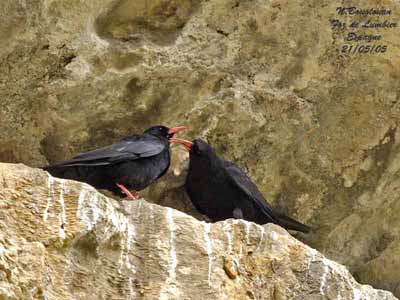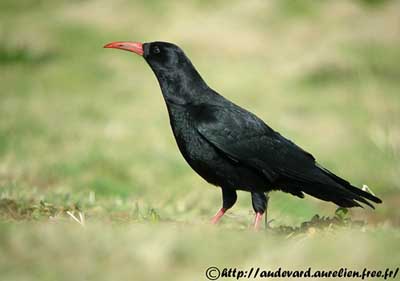
PROTECTION / THREATS / STATUS:
Red-billed Chough populations are in decline in Europe, due to habitat and feeding areas loss. Changes in rearing and pastures involved the disappearance of insects living close to cattle. So, Red-billed Chough does not get its favourite food, and their numbers are declining.
Fr: Crave à bec rouge
All : Alpenkrähe
Esp: Chova Piquirroja
Ital: Gracchio corallino
Nd: Alpenkraai
Sd: Alpkråka
Photographers:
Aurélien Audevard
OUESSANT DIGISCOPING
Nicole Bouglouan
PHOTOGRAPHIC RAMBLE
Texte de Nicole Bouglouan
Sources:
HANDBOOK OF THE BIRDS OF THE WORLD Vol 14 by Josep del Hoyo-Andrew Elliot-David Christie - Lynx Edicions –
ISBN: 9788496553507
THE HANDBOOK OF BIRD IDENTIFICATION FOR EUROPE AND THE WESTERN PALEARCTIC by Mark Beaman, Steve Madge - C.Helm - ISBN: 0713639601
THE COMPLETE BOOK OF BRITISH BIRDS – Written by “Royal Society for the Protection of Birds” experts - Préface de Magnus Magnusson - Michael Cady- Rob Hume Editors - ISBN: 0749509112
ENCYCLOPEDIE DES OISEAUX DE FRANCE ET D’EUROPE – de Peter Hayman et Rob Hume - Flammarion – ISBN : 2082009920
Pájaros de España (JL Beamonte)
Wikipedia (Wikipedia, The Free Encyclopedia)
Red-billed chough
Pyrrhocorax pyrrhocorax
Passeriforme Order – Corvidae Family
BIOMETRICS:
Length: 38-41 cm
Weight: 207-375 g
DESCRIPTION:
Red-billed Chough has bright blue black plumage, with green sheen on wings and tail. Wings are long and broad with long primaries.
Eyes are black. Down curved bill is red and slender. Legs and feet are red, with black claws.
Both sexes are similar.
Juvenile is duller than adults, with dull orange bill, and pinkish or dusky legs.

The 8 subspecies differ in size, and in intensity of glossy areas.
VOICE: SOUNDS BY XENO-CANTO
Red-billed Chough is very vocal all year round. Most common call is a ringing and pleasant yelping “kwee-ow” and “chee-a”. This call may be uttered both in flight and on ground.
Alarm call is a distinctive “ker-ker-ker” or a single “karr”.
Both mates utter soft warbling when resting together.
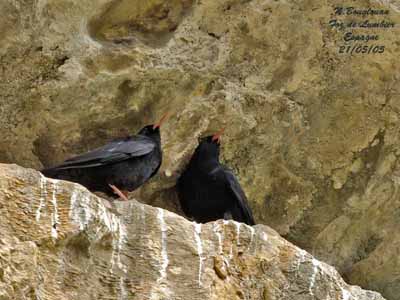
HABITAT:
Red-billed Chough breeds in high mountains and coastal cliffs, but with adjacent short grass pastures. It is also found in grassy and cultivated areas with rocky crags.
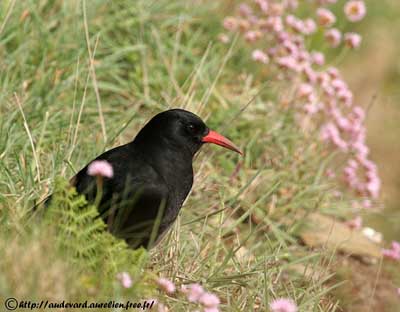
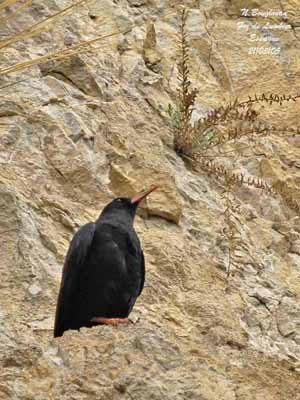
RANGE:
Red- billed Chough breeds in southern Europe and Mediterranean Basin, and also in Great Britain, Isle of Man, Ireland, and across Asia, India and China.
We can find a population in Ethiopia (Ethiopian Highlands), and also on high altitudes in the Himalayas where it is local resident.
Red-billed chough is resident in its range, but it may reach lower altitudes in winter.
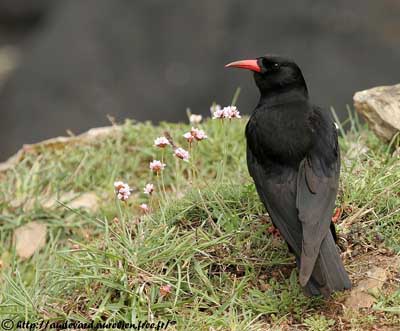
BEHAVIOUR:
Red-billed Chough feeds on maritime heaths and pastures at the top of cliffs.
When on ground, it may walk, hop or run quickly on short distance.
It is a gregarious species, and they gather in groups to feed in short grassy areas. They are often seen in pairs or in small flocks, but also in large groups of hundreds of birds.
Each group has a hierarchy, and the birds may live and feed together without any problem. Young need 2 to 3 years within a group to get their own status, with some aggressive but rarely important fights.
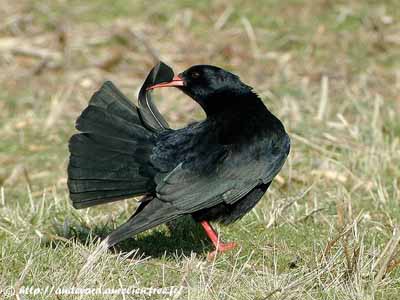
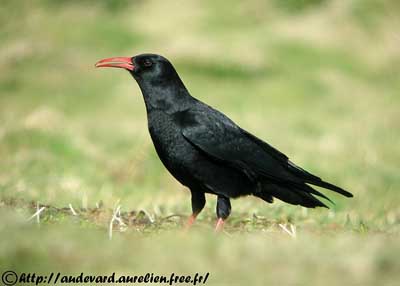
When food resources are reduced, dominant birds are able to find food enough, in order to survive and breed successfully.
During the breeding season, Red-billed Chough pair defends strongly its territory, chasing away any intruder able to threaten the nest site. If a predator comes too close, the choughs perform spectacular aerial displays, to defend young still dependent within the group.
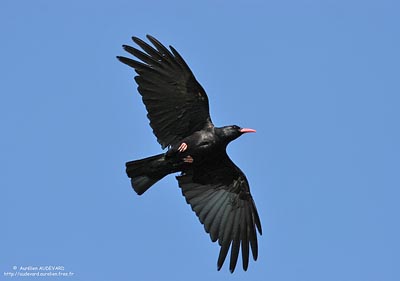
Red-billed Choughs are very good fliers, flying along cliffs in small groups with agile and buoyant flight. During the flight, we can see the well separated primary feathers of the wings, giving this bird its typical silhouette.
Red-billed Chough utters its typical call from a perch, while flicking wings and tail.
Each pair defends a territory where it nests and lives. Pair bonds are strong. Courtship displays include wonderful aerial displays in spring, before establishment of nest site in crevices or cavities in cliffs or crags.
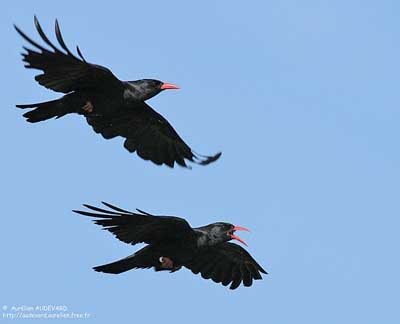
FLIGHT:
Red-billed Chough performs a superb and very graceful flight. It likes to play in thermal currents, performing vertiginous dives and acrobatic swoops. It soars effortless, and rises with the wind, crossing contrary winds to stop before diving with strong wing beats to get good speed. Then, it glides easily, and slewing its wide tail, it turns into the wind and rises again rapidly, performing a close turn while it goes forwards drifting slightly on the side.
It is the only bird in the world able to perform this aerial display.
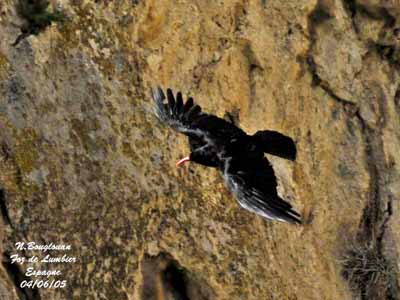
REPRODUCTION:
Red-billed Chough’s nest is a bulky loose structure, made with twigs and roots, linked by mud. This nest is lined with soft materials such as wool and hair. It is located in rocky crevices or cavities, cliff ledges, buildings, but also in mountain caves. Both parents take part in nest building.
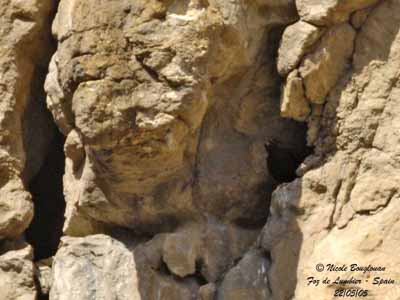
Female lays, between March and May, 3 to 5 pale buff, creamy or green eggs, with various brown and grey markings. Incubation lasts about 17 days, and female starts to incubate when the first egg is laid. She is often fed by the male while she sits on the nest, but sometimes, she joins its mate to feed with it and a small group.
Altricial chicks are tended and brooded by female the first ten days. She gives them small bits of food brought by the male. When young reach 5 to 7 days of age, both adults feed them by regurgitation of invertebrates.
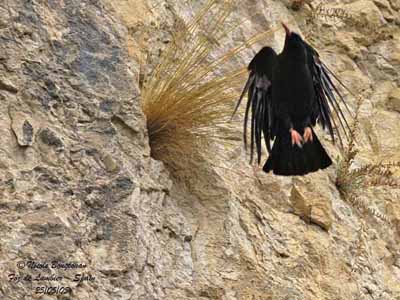
When young reach their complete plumage, at about 38 days of age, they shelter into individual hidden places near to the nest, from where they rush out with noise to be fed by adults.
One week later, they follow the adults and learn how to feed themselves. They become independent one month later, but they remain in the family group until the next breeding season.
These young may help their parents to raise the chicks of the following clutch the next year. They reach their sexual maturity at 2-3 years.
DIET:
Red-billed Chough feeds on terrestrial invertebrates, mainly insects and larvae, Coleoptera, Lepidoptera and Formicidae. It catches caterpillars, grasshoppers, bugs, spiders and earth worms, and rarely some small vertebrates.
It also consumes seeds and berries in winter.
